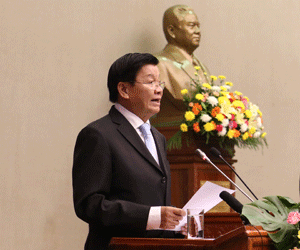The government yesterday asked the National Assembly (NA) to lower economic growth targets over the next four years after encountering difficulties that resulted in failure to meet the target set for last fiscal year.
Prime Minister Thongloun Sisoulith presented the proposal at the second ordinary session of parliament’s 8th Legislature, which opened yesterday.
Under the proposed plan, economic growth targets have been revised to 7 percent for 2017 and 2018, with a slight increase to 7.3 percent in 2019, rising further to 7.5 percent in 2020.
On average, the annual growth target over the next four years will be 7.2 percent, which is less than the annual average target of at least 7.5 percent set in the five-year National Socio-economic Development Plan for 2016-2020.
“Through thorough and objective analysis and discussions at the plenary meetings of the Central Party Committee and Politburo, the government has recognised the need to ask [the NA] to revise the macro targets,” Mr. Thongloun told NA members.
During last fiscal year 2015-16, which ended in September, economic growth was just 6.9 percent. The new fiscal year 2017 will begin on January 1.
Minister of Planning and Investment Dr Souphanh Keomixay told parliament that impacts from the regional and global economy contributed to Laos’ failure to meet last fiscal year’s growth target. Budget constraints faced by the government were a further setback.
Presenting the proposed revised plan to the NA session, Dr Souphanh said annual Gross Domestic Product (GDP) growth had been revised to 7.2 percent on average over the next four years. GDP per capita is targeted to reach US$2,978 (more than 24.2 million kip) by 2020, up from the US$2,027 recorded in 2016.
To pursue these targets, overall investment capital of 173,328 billion kip is required, representing 29 percent of GDP. Of this, 12-15 percent will come from the state budget, 15-24 percent from loans and official development assistance, 40-49 percent from domestic and foreign private investment, and 21-23 percent from banking systems .
Over the next four years, revenue is expected to reach 18-19 percent of GDP, while expenditure is targeted at 21-25 percent with a budget deficit of 4-5 percent.
The proposed revision came after GDP growth for last fiscal year failed to meet the target after being impacted by the regional and global economies as well as budget constraints in Laos, with these issues likely to continue to affect the economy.
Initial information from the Ministry of Finance showed that revenue collection for last fiscal year reached only about 95 percent of the plan, even after the plan was adjusted for lower revenue and spending figures.
In April this year, the NA passed the government’s proposal to adjust the budget. The adjustment reduced revenue collection from the original target of 26.159 trillion kip down to 23.7 trillion kip while expenditure was lowered from 31.946 trillion kip to 31.118 trillion kip.
In 2017, GDP is expected to grow by 7 percent amounting to 129,683 billion kip with GDP per capita equivalent to US$2,341 (more than 19 million kip) and Gross National Income per capita reaching US$1,850 (more than 15 million kip).
In pursuit of the 2017 macro targets, Prime Minister Thongloun has promised that the government will stabilise the macro economy by amending and formulating policies and regulations that are conducive to effective economic management.
The government will continue to strengthen financial and budgetary management in a bid to resolving budgetary difficulties by modernising revenue collection methods and expanding revenue generating sources.
Meanwhile, the prime minister pledged to inspect the implementation of the budget to ensure its effectiveness and to rein in state spending.
“The government will prevent unapproved projects from being created to avoid unapproved debts so that state investment is legally regulated and transparent,” he told parliament.
The government pledged to stabilise currency in line with market-orientated mechanisms, while defining appropriate interest rates to be offered by commercial banks.
Mr. Thongloun said the government would continue to streamline procedures and regulations conducive for easing investment and business operations, while cutting unnecessary costs.
The government has also vowed to place greater importance on small and medium enterprises.
Source: Vientiane Times



